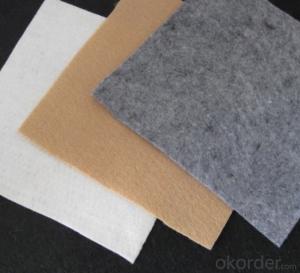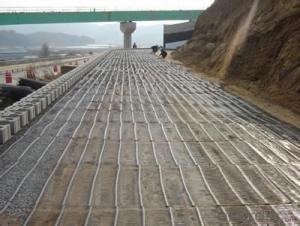Pot Geotextile PP Biaxial Geogrid with CE Certificate
- Loading Port:
- China Main Port
- Payment Terms:
- TT OR LC
- Min Order Qty:
- -
- Supply Capability:
- -
OKorder Service Pledge
OKorder Financial Service
You Might Also Like
Specifications
1. OEM and ODM
2. virgin material
2. CE, ISO 9001, MA,CNAS, AL, IGS Member
3. Ten more years biaxial geogrid suppliers
PP biaxial geogrid (TGSG1515-3030)
Specification & index:
Specification |
| TGSG15-15 | TGSG20-20 | TGSG30-30 | TGSG40-40 |
Index | unit | MD CD | MD CD | MD CD | MD CD |
true initial modulus in use | KN/m | 15 15 | 20 20 | 30 30 | 40 40 |
true tensile strength @2% strain | KN/m | 5 5 | 7 7 | 11 11 | 16 16 |
true tensile strength @5% strain | KN/m | 7 7 | 14 14 | 21 21 | 32 32 |
junction efficiency | % | 100 | 100 | 100 | 100 |
flexural stiffness | mg-cm | 280,000 | 780,000 | 900,000 | 1,200,000 |
aperture stability | kg-cm/deg | 3.1 | 4.8 | 4.3 | 3.4 |
resistance to installation damage | %SC/%SW/%GP | 95/93/90 | 95/93/90 | 95/93/90 | 95/93/90 |
resistance to long term degradation | % | 100 | 100 | 100 | 100 |
unit weight | g/m2 | 250-310 | 270-330 | 340-420 | 430-530 |
rolls dimensions (length, width) | m | 50*3.9 | 50*3.9(5) | 50*3.9 | 50*3.9 |
loading capacity | rolls/40HC | 205 | 180 | 120 | 88 |
Application:
PP biaxial geogrids can be used to enhancement of permanent bearable soft including highway and railways embankment, slopes, tunnel, airport, parking lots, loaded pier and ground and their main usage are as follows:
1. enhance the bearing capacity fo road foundation and extend the duration of highway.
2. prevent highway surface from collapse, crack and being dirty.
3. be convenient for construction timesaving and cut down the cost of maintenance.
4. prevent tunel from crack occuring
5. further solidity slopes to proof water and soil from losses
6. reduce the surface thickness of the ground.
7. consolidate the net for growing grass on the slopes
so as to stabilization surrounding virescence.
8. be used for artificial top net of mines instead of metal ones.
It is of flame retardant and antistatics.
- Q: Geotextile in the asphalt layer under what role
- The main role is isolation, drainage. Id phone manufacturers
- Q: How do geotextiles contribute to the durability of civil engineering structures?
- Geotextiles contribute to the durability of civil engineering structures by providing reinforcement, filtration, and separation. They act as a strong and stable barrier against soil erosion, preventing the movement and loss of soil particles. This reinforcement helps to maintain the integrity of the structure, especially in areas prone to high water flow or soil instability. Additionally, geotextiles act as a filtration layer, allowing water to pass through while preventing the migration of fine particles that could clog drainage systems. This filtration helps to maintain the functionality of the structure and prevent damage caused by water buildup. Furthermore, geotextiles aid in the separation of different layers of soil or materials, preventing mixing and maintaining the structural stability of the construction. Overall, geotextiles play a vital role in enhancing the durability and longevity of civil engineering structures.
- Q: Are geotextiles suitable for use in stormwater management systems?
- Yes, geotextiles are suitable for use in stormwater management systems. They have proven to be effective in filtering sediment and pollutants from stormwater runoff, reducing erosion, and promoting infiltration. Geotextiles can enhance the performance and longevity of stormwater management systems by providing additional support, strength, and stability to the infrastructure.
- Q: How do geotextiles help with reinforcement of geogrid wall systems?
- Geotextiles help with the reinforcement of geogrid wall systems by acting as a separation and filtration layer. They prevent the mixing of different soil layers, which can compromise the stability of the wall system. Additionally, geotextiles help to distribute the loads evenly across the geogrids, enhancing their strength and overall performance.
- Q: What are the factors that affect the effectiveness of geotextiles in erosion control?
- The factors that affect the effectiveness of geotextiles in erosion control include the type and quality of the geotextile material, the installation method and technique, the slope gradient and soil conditions, the presence of vegetation, and the level of maintenance and monitoring.
- Q: 250 grams of two cloth a film 0.8 thick geotextile what price
- 250 grams of two cloth a film 0.8 thick geotextile per square meter between about 10 yuan -13 yuan, the current price is the lowest in recent years.
- Q: How do geotextiles aid in the reduction of soil compaction?
- Geotextiles aid in the reduction of soil compaction by providing a layer of material that distributes the load more evenly, reducing the pressure on the soil. This helps to improve soil structure, increase porosity, and enhance drainage, ultimately preventing soil compaction.
- Q: Geotextile (two cloth a film) to detect the frequency requirements? On behalf of the number?
- Geotextile and geomembrane detection frequency is 100 volumes detection time.
- Q: What does geotextile mean?
- Geotextile, also known as geotextile, it is made of synthetic fiber through acupuncture or woven from the permeability of geosynthetics. Geotextile is a new material geosynthetics which one, the finished product for the cloth, the general width of 4-6 meters, the length of 50-100 meters. Geotextile is divided into a spinning geotextile and non-woven filament geotextile. First, the characteristics: 1, high strength, due to the use of plastic fibers, in dry and wet state can maintain full strength and elongation. 2, corrosion-resistant, in different pH of the soil and water can be long-term corrosion resistance. 3, good water permeability between the fiber gap, it has a good water permeability. 4, good microbial resistance to micro-organisms, insects are not damaged. 5, construction convenience, as the material light, soft, so the delivery, laying, construction convenience. 6, complete specifications: width of up to 9 meters. Is currently the widest product, the unit area quality: 100-1000g / ㎡. Second, the role: 1, isolation 2, filtration 3, drainage 4, reinforced 5, protection 6, anti-puncture
- Q: What are the different testing methods for geotextiles?
- There are several testing methods for geotextiles, including tensile strength testing, puncture resistance testing, tear resistance testing, elongation testing, and permeability testing. These methods help assess the performance and quality of geotextiles in various applications, such as soil stabilization, erosion control, and drainage systems.
Send your message to us
Pot Geotextile PP Biaxial Geogrid with CE Certificate
- Loading Port:
- China Main Port
- Payment Terms:
- TT OR LC
- Min Order Qty:
- -
- Supply Capability:
- -
OKorder Service Pledge
OKorder Financial Service
Similar products
Hot products
Hot Searches
Related keywords
























